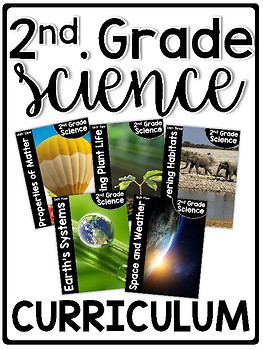2nd Grade Science Curriculum Bundle
- Zip
What educators are saying
Products in this Bundle (5)
Description
This bundle is designed for the second grade classroom and easily adapted to fit a guardian-led homeschool setting! If inquiring about this bundle for a homeschool setting, feel free to email me directly with any questions at tara@littlemindsatwork.org!
2nd Grade Science Curriculum
Thanks so much for viewing my 2nd Grade Science Curriculum units bundled. 2nd Grade Science Curriculum is an engaging science curriculum with young learners in mind! 2nd Grade Science Curriculum is standards-based and encourages young learners to think “outside the box” and prove their thinking through hands-on and engaging learning experiences.
What is 2nd Grade Science Curriculum?
2nd Grade Science Curriculum is an engaging science curriculum with young learners in mind! 2nd Grade Science Curriculum is standards-based and encourages young learners to think “outside the box” as well as prove their thinking through hands-on and engaging learning experiences. 2nd Grade Science Curriculum is based upon five units: Properties of Matter, Plant Life, Ecosystems, Earth’s Systems, and Space/Weather. Each unit is broken down into 10 lessons, and each lesson can take from 1-2 days to complete. Each unit covers at least two weeks of instruction. The lesson plan has the standards covered, materials list, lesson vocabulary, detailed activity lesson plans, and all necessary student follow-up practice sheets.
2nd Grade Science Curriculum encourages a daily routine, but please know that as the teacher you can adjust the lessons and make them best work for your daily schedule and time allotment. With each lesson the students will partake in a quick lesson opener and skill lesson. Each day the students will take part in hands-on or think-provoking activity. Please note that all student follow-up practice sheets can be shrunk and placed into a student science journal. You can also choose to have students track their daily science activities in their journal with or without the included response sheets.
What is included in each unit?
- 2 weeks of lesson plans (editable version included)
- Custom written books (can be printed or displayed on an interactive board)
- Daily printable practice (can be placed in a science journal)
- Necessary printable lesson cards/games
- Vocabulary cards
What Units Are Included in 2nd Grade Science Curriculum
Unit One: Properties of Matter INCLUDED
Lesson 1: Matter (Define)
Lesson 2: Solid, Liquid, Gas
Lesson 3: Liquid Experiment
Lesson 4: Solid Experiment
Lesson 5: Gas Experiment
Lesson 6: Liquid to Solid
Lesson 7: Liquid to Gas
Lesson 8: Irreversible Change
Lesson 9: Reversible Change
Lesson 10: Disassemble Change
Unit Two: Exploring Plant Life INCLUDED
Lesson 1: Plant Needs
Lesson 2: Scientific Process
Lesson 3: Make an Experiment Plan
Lesson 4: Plant Needs Experiment
Lesson 5: Plant Habitats
Lesson 6: Parts of a Plant
Lesson 7: Plant Roots Experiment
Lesson 8: Photosynthesis
Lesson 9: Pollination
Lesson 10: Dispersal of Seeds
Unit Three: Discovering Habitats INCLUDED
Lesson 1: Ecosystems
Lesson 2: Levels of Ecosystems
Lesson 3: Biome Classification
Lesson 4: Desert Biome
Lesson 5: Aquatic Biome
Lesson 6: Forest Biome
Lesson 7: Grassland Biome
Lesson 8: Tundra Biome
Lesson 9: Biome Model
Lesson 10: Habitat Comparison
Unit Four: Earth's Systems INCLUDED
Lesson 1: Earth’s Water
Lesson 2: Water Cycle
Lesson 3: Rapid Earth Changes
Lesson 4: Slow Earth Changes
Lesson 5: Comparing Earth’s Changes
Lesson 6: Water Erosion
Lesson 7: Wind Erosion
Lesson 8: Glacial Erosion
Lesson 9: Solving Erosion
Lesson 10: Erosion Presentation
Unit 5: Space and Weather INCLUDED
Lesson 1: Weather
Lesson 2: Clouds
Lesson 3: Weather Patterns
Lesson 4: Weather Patterns (continued)
Lesson 5: Weather Experiment
Lesson 6: The Sun (a star)
Lesson 7: The Sun’s Movement
Lesson 8: The Sun (energy source)
Lesson 9: The Moon
Lesson 10: Moon Phases
Can I teach the units out of order?
Yes, you can teach them out of order to fit your needs and pacing!
What About Standards?
The units are based upon commonly used state science standards as well as the Next Generation Science Standards! Below are the NGSS standards!
Unit 1: 2.Structure and Properties of Matter
2-PS1-1. Plan and conduct an investigation to describe and classify different kinds of materials by their observable
properties.
2-PS1-2. Analyze data obtained from testing different materials to determine which materials have the properties that are
best suited for an intended purpose.
2-PS1-3. Make observations to construct an evidence-based account of how an object made of a small set of pieces can be
disassembled and made into a new object.
2-PS1-4. Construct an argument with evidence that some changes caused by heating or cooling can be reversed and some
cannot.
Unit 2: 2.Interdependent Relationships in Ecosystems
2-LS2-1. Plan and conduct an investigation to determine if plants need sunlight and water to grow.
2-LS2-2. Develop a simple model that mimics the function of an animal in dispersing seeds or pollinating plants
Unit 3: 2.Interdependent Relationships in Ecosystems.
2-LS4-1. Make observations of plants and animals to compare the diversity of life in different habitats.
Unit 4: 2.Earth’s Systems: Processes that Shape the Earth
2-ESS1-1. Use information from several sources to provide evidence that Earth events can occur quickly or slowly.
2-ESS2-1. Compare multiple solutions designed to slow or prevent wind or water from changing the shape of the land.
2-ESS2-2. Develop a model to represent the shapes and kinds of land and bodies of water in an area.
2-ESS2-3. Obtain information to identify where water is found on Earth and that it can be solid or liquid.
Unit 5: *Adapted from multiple state standards*
Realize that the sun is our nearest star and that its position in the sky appears to change.
Make observations of changes in the moon's appearance over time.
Associate temperature patterns with seasonal changes.
Explain why the sun is the primary source of the earth's energy.
Identify types of clouds.
View the preview to see the units in action!
Visit my blog Little Minds at Work
Follow me on Facebook




